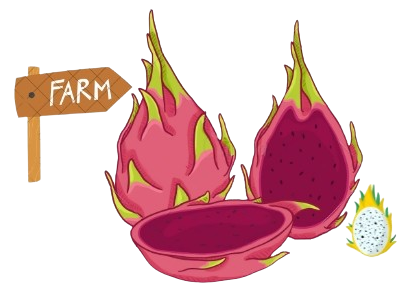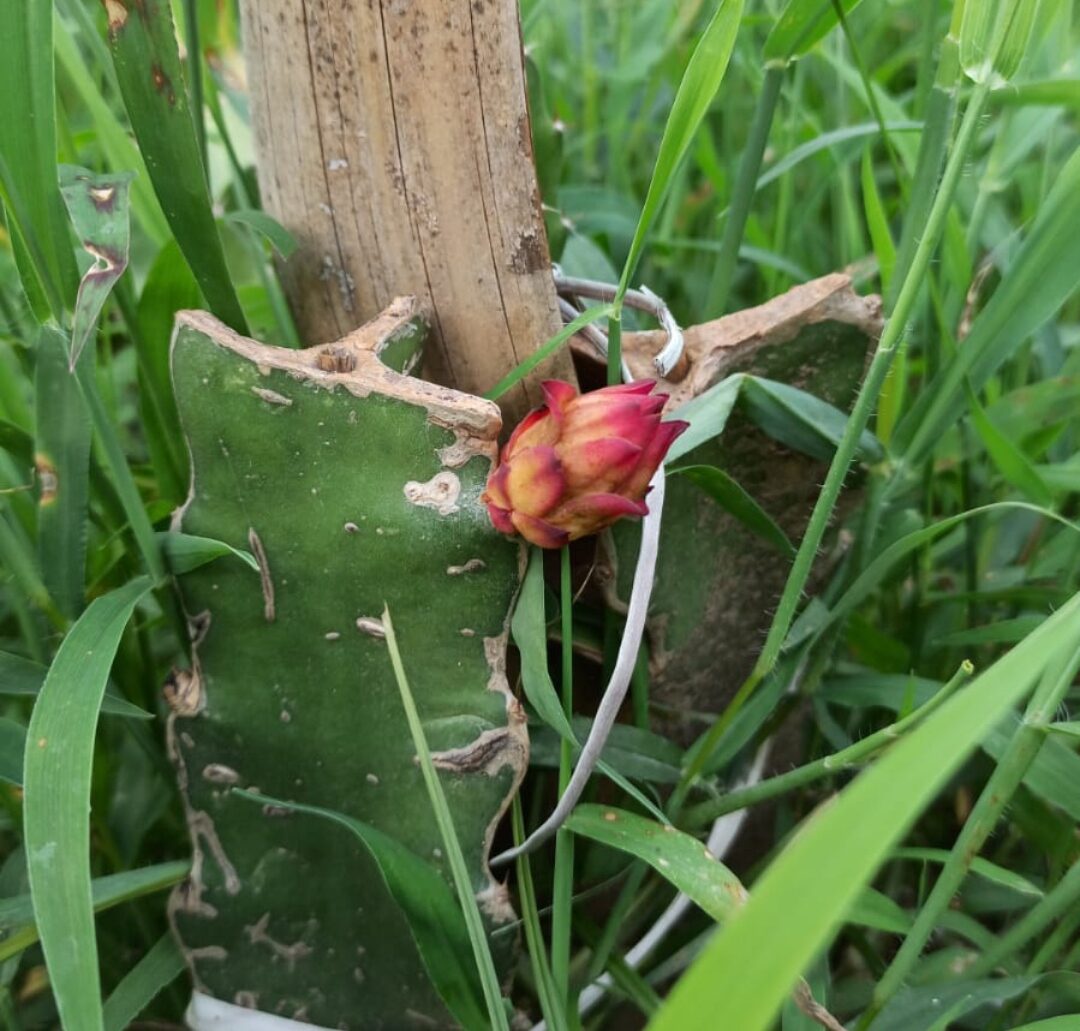dragon fruit farming in monsoon is relatively new in India, and many farmers are still learning how to manage the crop effectively. One major challenge they face is the unpredictable impact of rainfall during the flowering and fruiting stages, especially during the monsoon season (July to September). In this article, we’ll explore how rainfall affects dragon fruit flowering, fruit development, nutritional value, pest attacks, and ultimately, its market price. This guide is written with beginner farmers in mind, ensuring all concepts are easy to grasp and practical to apply.
Dragon fruit farming in monsoon Affecting Dragon Fruit Price

Rainfall is both a friend and a foe to dragon fruit farming. While it supports growth by keeping the soil moist, too much rain during flowering and fruiting stages can negatively affect pollination, fruit development, and dragon fruit farming in monsoon ultimately hikes the price per kg a farmer gets in the market.
Let’s understand each aspect in simple, practical terms so you can manage your farm better during monsoon.
rain effect on dragon fruit yield

- Dragon fruit plants typically begin to flower in June or July, depending on regional climate.
- The arrival of monsoon increases air humidity, which naturally triggers flower buds to bloom.
- rain effect on dragon fruit yield As soon as flowers open, fruiting begins almost immediately, making this period highly sensitive to rainfall.
Why Pollination is Crucial for Dragon Fruit Farming
Dragon fruit farming in monsoon – Pollination is a vital process that helps the plant convert flowers into fruits.
There are two types of pollination in dragon fruit:
- Self-pollinated varieties: These don’t require manual pollination. The pollen transfers within the same flower naturally.
- Cross-pollinated varieties: These need hand pollination or help from insects like bees or moths to transfer pollen between flowers.
Without proper pollination, you may see:
- Flowers dropping without fruiting.
- Fruits forming incompletely or with poor shape.
- Lower fruit weight, which directly reduces your profit.
Rainfall Interrupts Natural Pollination
Here’s a problem many farmers face:
- Dragon fruit flowers bloom only at night and stay open for just one night.
- If it rains on that particular night, the raindrops wash away the pollen grains.
- Without pollen, fertilization cannot happen, and the flower fails to develop into a healthy fruit.
Result?
- Small or deformed fruits that can’t be sold at premium rates.
- Wasted efforts and reduced profit from that plant.
Impact of Incomplete Pollination on Market Price

- In the market, size matters a lot. Traders and customers prefer large, smooth, and well-formed fruits.
- Healthy dragon fruits can fetch ₹200–₹290 per kg, depending on quality.
- But if pollination fails due to rain, the fruit may be too small or underdeveloped to sell.
- This directly reduces your average price per kg and overall earnings from the crop.
A Simple Technique to Protect Flowers from Rain
dragon fruit price in monsoon – rain effect on dragon fruit yield for e.g. If you are growing self-pollinated dragon fruit varieties, here’s a practical method to protect your crop:
How to Save the Pollen Before Rain:
- Keep a close watch on flower buds in the evening.
- Just before the flower is about to open, gently tie a soft rubber band or cloth around the tip of the bud.
- This creates a shield that prevents rain from washing away the pollen.
- Once the rain passes, the flower will still open and natural pollination can occur safely.
Does Wrapping Harm the Plant?
Not at all.
- For self-pollinated plants, only the pollen needs to stay inside.
- The flower does not require air exposure or pollinators.
- Be gentle and remove the wrap the next morning if needed.
This one small step can protect your yield during the crucial flowering days of the monsoon.
Rainfall Also Affects Nutritional Value and Plant Health
dragon fruit farming in monsoon rain does not just affect pollination — it impacts the overall health of your plants and the quality of your fruits.
Loss of Essential Nutrients Due to Rain
When it rains continuously, key nutrients in the soil such as:
- Nitrogen (N) – for plant growth,
- Phosphorus (P) – crucial during fruit formation,
- Potassium (K) – for fruit quality,
…either get washed away (runoff) or become locked in the soil (fixed), where roots can’t absorb them.
Why Phosphorus Loss is Most Dangerous:
- dragon fruit farming in monsoon effects as Phosphorus is the most important nutrient during flowering and fruiting.
- When it gets washed away, the plant cannot form proper fruits, leading to poor yields.
Root Damage & Soil Saturation
- Heavy rains cause waterlogging, especially in poorly drained soil.
- This leads to root rot or causes shallow roots to come out of the soil, weakening the plant.
- A weak root system means less nutrient uptake, resulting in smaller, less juicy fruits.
Weed Growth: A Hidden Enemy in Rain
- Rain encourages fast growth of weeds, especially near dragon fruit bases.
- These weeds:
- Steal nutrients from the soil,
- Block sunlight, and
- Spread pests and diseases.
dragon fruit farming in monsoon has its own challenges like Uncontrolled weed growth can severely limit the growth and health of your dragon fruit plants during the rainy season.
Pest and Fungal Attack During Monsoon

Rain creates a warm, humid environment — perfect for pests and diseases to thrive.
Pest Problems
- Fruit flies are the most dangerous during monsoon.
- These pests are attracted to ripe fruits, lay eggs inside, and damage the fruit from within.
- You may not even see the damage from outside until the fruit starts to rot.
Fungal and Bacterial Diseases
Heavy and frequent rainfall increases:
- Fungal infections like stem rot and fruit rot.
- Bacterial soft rot caused by stagnant moisture on stems and fruit skin.
These infections spread fast and can:
- Reduce the number of harvestable fruits,
- Shorten the plant’s life, and
- Affect the price you get in the market.
Tip of the Day: How to Handle Dragon Fruit During Monsoon
Every successful dragon fruit farmer knows that dragon fruit farming in monsoon and monsoon is a double-edged sword. dragon fruit price in monsoon – rain brings moisture, but also many risks. So how can you turn this season into an advantage?
Let’s break down a rainy-season action plan that every farmer should follow:
- Prepare Drainage Systems in Advance
- Ensure your plantation has proper drainage trenches to avoid waterlogging.
- Elevate beds where possible or use mounds to keep roots safe.
- Use Mulching to Protect Soil Health
- Mulch with dry grass, coconut husk, or plastic sheets.
- This reduces nutrient runoff and controls weed growth naturally.
- Apply Phosphorus-Rich Fertilizers Before Heavy Rain
- Don’t wait until nutrients are gone.
- Apply fertilizers with phosphorus and micronutrients a few days before expected rainfall.
- Install Sticky Yellow Traps and Fruit Fly Lures
- These are inexpensive and very effective.
- Place traps around the farm to monitor and reduce pest populations.
- Use Bio-Fungicides as a Preventive Spray
- Spraying Trichoderma or Bacillus subtilis before rain can prevent fungal infections.
- Always spray in the evening when rain is not expected for the next few hours.
- Wrap and Monitor Flowers Closely
- For self-pollinated types, wrap flower buds before they open.
- For cross-pollinated plants, consider controlled pollination or introducing honeybees under net structures.
By following these steps, even new farmers can maintain good fruit quality and get better price per kg, even during the unpredictable rains of monsoon.
Tip of the Day: Mastering Rain-Proof Farming Techniques
During the monsoon, dragon fruit farmers face many natural challenges, but the right techniques can help reduce damage and increase profit.
Rain Protection Methods for Better Pollination and Fruit Set
- Use Shade Nets or Temporary Covers
Install a plastic sheet or a shade net above your dragon fruit rows. This simple setup prevents direct rain from hitting flowers and fruits, especially on nights when blooming is expected. - Early Morning Checks
Since flowers bloom at night, inspect the plants early in the morning for any signs of damaged buds or washed-off pollen. This habit helps you decide quickly if manual pollination is needed. - Hand Pollination When Necessary
For cross-pollinated varieties or where natural pollination fails, use a soft brush to transfer pollen from one flower to another at night or early morning. This may seem time-consuming, but even partial hand pollination can significantly improve yield. - Prepare Nutrient-Rich Soil Before Monsoon
Add organic compost and phosphorus-rich fertilizers like bone meal or rock phosphate before the monsoon to reduce nutrient wash-off. Use mulching to prevent soil erosion. - Monitor Drainage Closely
Ensure your dragon fruit farm has a good slope or drainage system. Accumulated water near roots not only damages the plant but also encourages fungal infections.
By applying these five strategies, you will protect your plants, improve fruit size and quality, and ultimately secure better prices in the market. Consistency in these practices leads to long-term rewards, even in unpredictable weather.
(FAQ)
Q1. What is the average dragon fruit price per kg in India?
Answer: Dragon fruit can sell from ₹100 to ₹290 per kg, depending on size, color, and freshness. Larger, brighter fruits fetch premium prices.
Q2. When does dragon fruit flowering begin?
Answer: Flowering starts as humidity increases, typically from June to July, depending on your region.
Q3. Does hand pollination give better results?
Answer: Yes, hand pollination offers more reliable fruit set, especially in cross-pollinated varieties. However, on large farms, beekeeping is used to help with pollination.
Q4. Can rainfall permanently damage dragon fruit plants?
Answer: Not usually, but continuous waterlogging can lead to root rot and stem infections, which reduce plant life.
Q5. What kind of fertilizer is best before the rainy season?
Answer: Use slow-release fertilizers rich in phosphorus (P) and organic compost to improve soil structure and nutrient retention.
Q6. How can I protect dragon fruit flowers from rain?
Answer: If using self-pollinated varieties, tie a soft cloth or rubber band around the bud before it blooms to prevent water damage.
Q7. Are weeds a serious problem during monsoon?
Answer: Yes, weeds grow quickly in wet conditions and compete for nutrients, which can weaken your plants.
Q8. How do I identify fungal infection on dragon fruit?
Answer: Look for black spots, mushy stems, or fruit discoloration. Treat early using organic fungicides like neem oil or copper-based solutions.
Q9. What is the ideal drainage setup?
Answer: Slightly raised beds with side trenches help prevent water accumulation. Avoid planting in low-lying areas.
Q10. Can I grow dragon fruit in heavy rainfall areas?
Answer: Yes, but you must ensure proper rain management, regular monitoring, and timely interventions to prevent loss.


Good Information